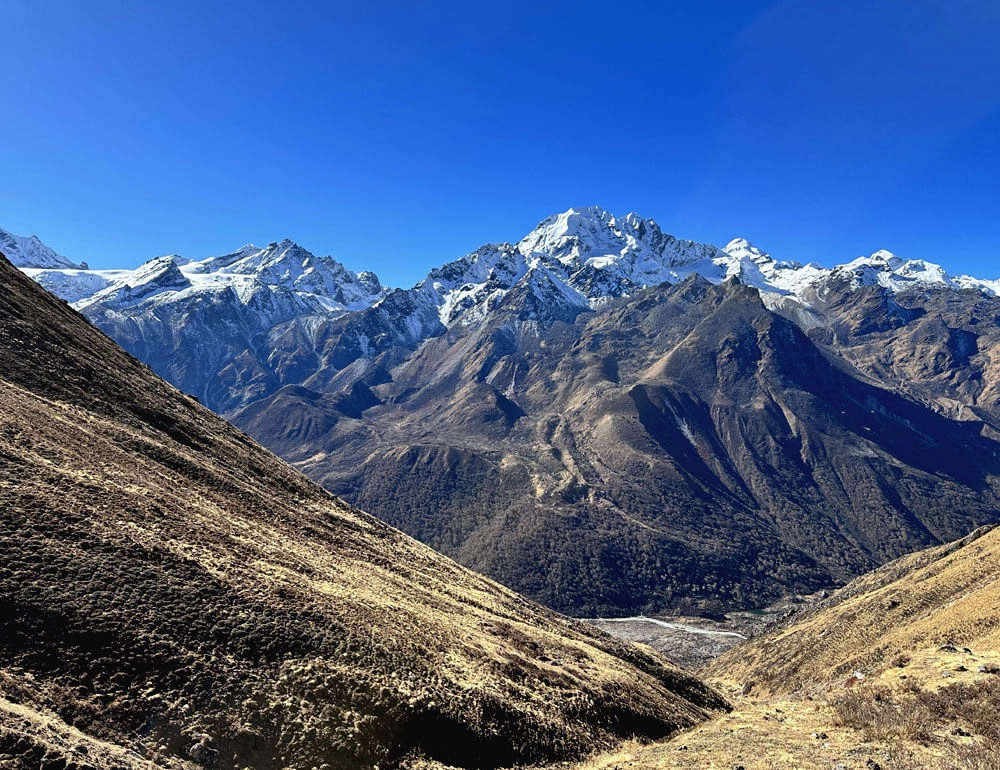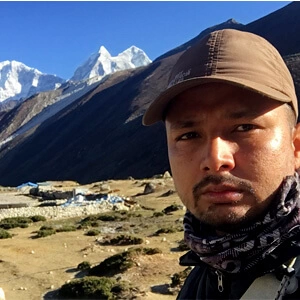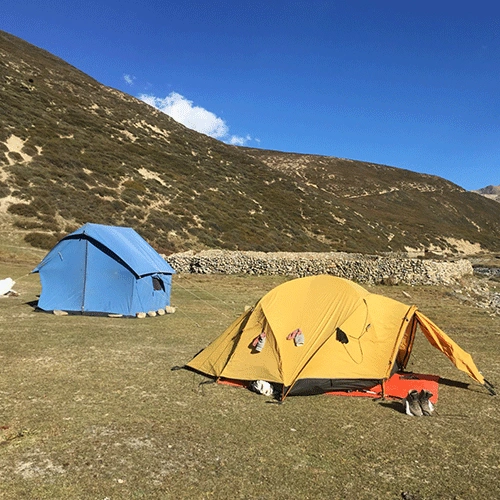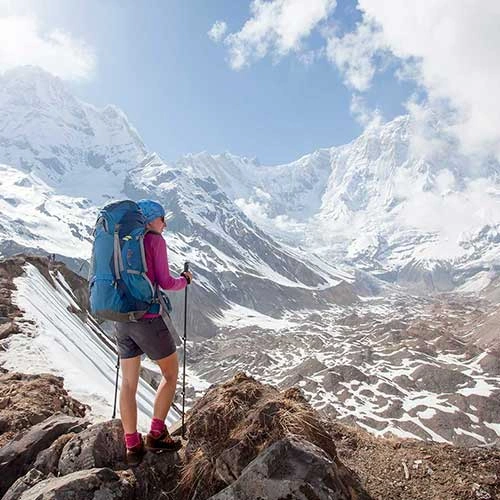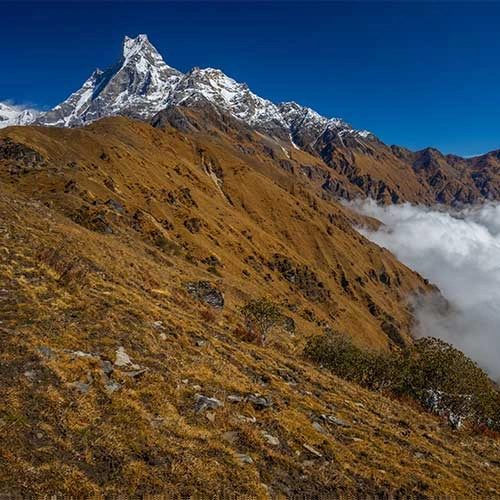Best One Week Treks in Nepal
Langtang Valley Trek
The Langtang Valley Trek offers marvelous views and an exhilarating trekking experience in the pristine Langtang Region. The trek begins from Syabrubesi. The starting point is easily accessible from Kathmandu. Thus, it is highly recommended if you are looking for a one-week trek in Nepal.
The trek is ideal for individuals seeking a peaceful ambiance and an opportunity to witness the stunning beauty of the Himalayas. The trek takes you through Langtang National Park, where you may spot a varied range of wildlife and bird life.
This one-week trek rewards you with striking views of mountains such as Ganesh Himal, Langtang Lirung, Dorje Lakpa, and other nearby mountains. In addition, you can witness the distinct culture of the Tamang people, experience their warm hospitality, and explore the region leisurely.
In one week, you will pass through traditional villages like Lama Hotel, Langtang Village and the charming Kyanjin Gompa. These villages offer an authentic glimpse into the local way of life. You will also have the chance to visit age old monasteries during the trek. In addition, a rewarding hike to Kyanjin Ri provides panoramic views of Langtang and enhances your sightseeing experience.
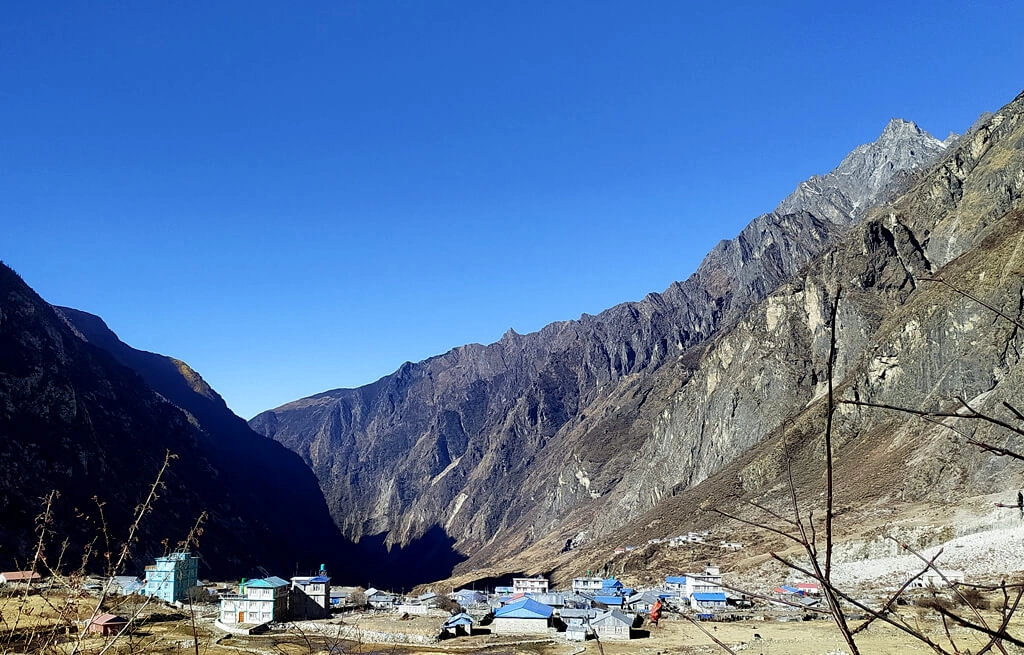
7 day Langtang Valley Trek Outline Itinerary
- Day 1: Drive fromKathmandu (1,400 m) to Syabrubesi (1,550 m)
- Day 2: Trek from Syabrubesi (1,550 m) to Lama Hotel (2,380 m)
- Day 3: Hike from Lama Hotel (2,380 m) to Langtang Village (3,430 m)
- Day 4: Trek to Kyanjin Gumba (3870 m)
- Day 5: Early morning hike to Kyanjin Ri (4,773 m), then Trek to Ghoda Tabela (3,030 m)
- Day 6: Trek back to Syabrubesi (1,550 m)
- Day 7: Drive from Syabrubesi (1,550 m) to Kathmandu (1,400 m)
Mardi Himal Trek
Mardi Himal Trek is a rewarding trek that offers a tranquil and scenic journey taking you to the most pristine places of the Annapurna Region. The trek is perfect for trekkers seeking a peaceful experience far from crowded trekking trails.
This 7 day Trek offers phenomenal scenery of stunning mountains. You will trek through the serene traditional villages and pristine forests. Thus, the trek is perfect for adventurers seeking a more serene, peaceful experience.
The trek begins with an adventurous drive to Dhampus. From Dhampus, you will trek through the dense forest and terrace climbing gradually towards Forest Camp, Low Camp, and High Camp before reaching the alluring Mardi Himal Base Camp.
At the base camp of Mardi Himal you will be rewarded with the magnificent close-up scenery of the Himalayan peaks such as Annapurna, Machhapuchhre, Hiunchuli, and the other peaks. The views are stunning and make the journey delightful.
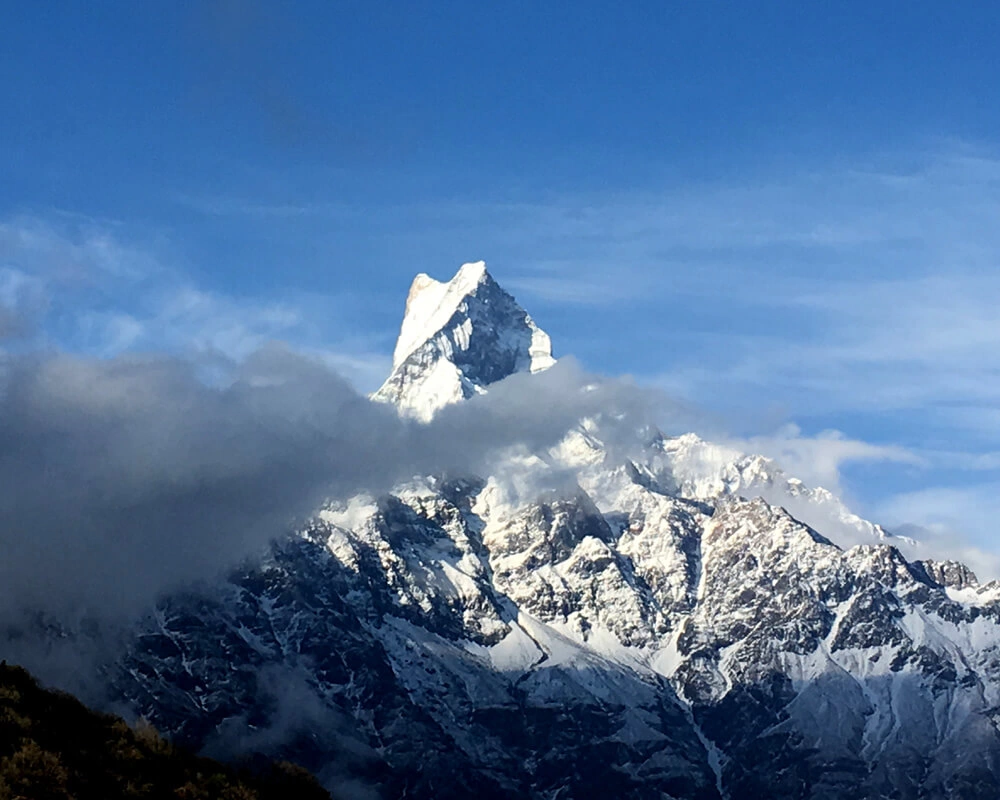
Outline Itinerary of Mardi Himal Trek
- Day 1: Drive to Pokhara (822 m) from Kathmandu (1,400 m)
- Day 2: Drive to Dhampus (1,650 m) from Pokhara (822 m) and Trek to Forest Camp (2,550 m)
- Day 3: Trek from Forest Camp (2,550 m) to either Low Camp (3,050 m) or Badal Danda (3210 m)
- Day 4: Trek to Mardi High Camp (3,900 m)
- Day 5: Early morning hike to Mardi Himal Base Camp (4,500 m) and Trek to Sidhing Village (1,700 m)
- Day 6: Drive back to Pokhara (822 m)
- Day 7: Drive to Kathmandu (1,400 m) from Pokhara (822 m)
Ghorepani Poonhill Trek
Ghorepani Poon Hill Trek is a short and relatively easy trek that presents exceptional views of the Himalayas. This scenic trek is an ideal choice for novice trekkers. The trek can be completed in a week in a duration of 5 to 7 days. This enchanting week long trek provides chances to explore the Annapurna region leisurely. In addition, you can also have intriguing cultural exploration opportunities.
The trek's peak elevation is lower than other treks in Nepal. In addition, the trails leading to Poon Hill are well paved. So, the trek is suitable for the new trekkers who wish to experience the tranquility of the Himalayas.
The trek begins with a drive to Banthanti from Pokhara. Then the trek winds through charming mountain villages such as Ulleri and Ghorepani. The highlight of the trek is Poonhill. From this vantage point, you can see mountains like Machhapuchhre, Tukuche, Nilgiri, Annapurna, Gurja, Dhaulagiri and many others.
In addition to the stunning natural beauty, this journey offers a chance to observe local culture. You can interact with the people from the Gurung and Magar communities. You can experience their warm reception, which will enhance your journey. The sunrays make majestic mountains turn golden, presenting alluring scenery. This makes the early morning climb to Poon Hill a truly unforgettable experience.
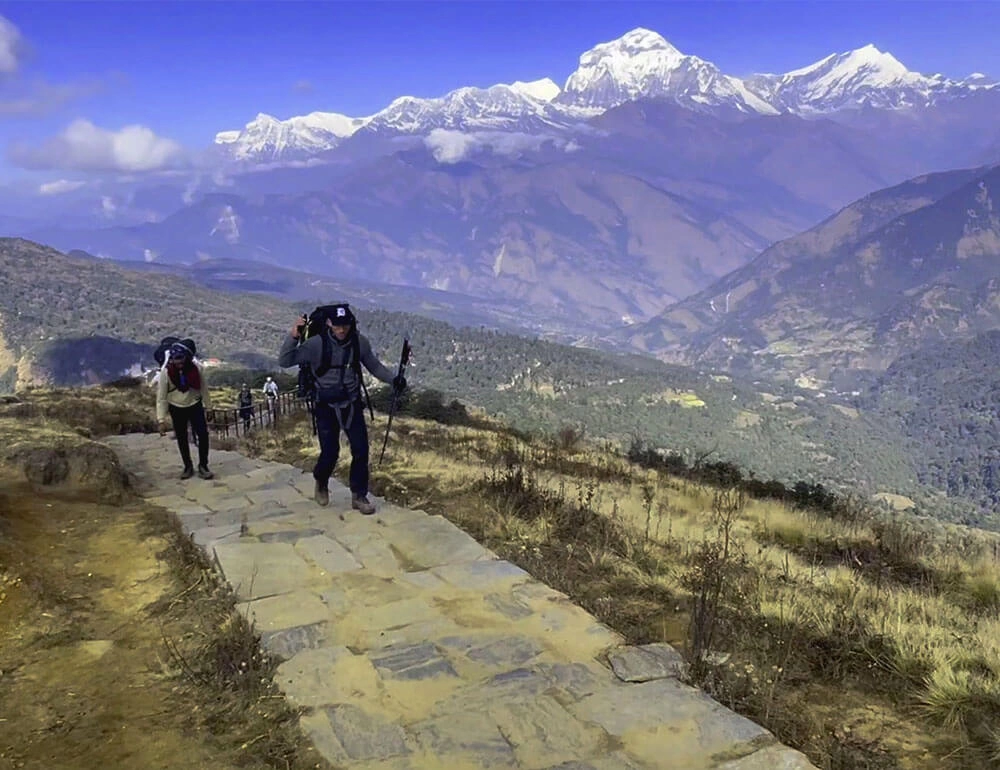
Ghorepani Poon Hill Trek Outline Itinerary
- Day 1: Arrival in Kathmandu (1,400 m)
- Day 2: Drive from Kathmandu (1,400 m) to Pokhara (822 m)
- Day 3: Drive to Banthanti and trek to Ghorepani (2,874 m)
- Day 4: Hike to Poon Hill for sunrise views, then trek to Tadapani (2,630 m)
- Day 5: Trek to Ghandruk from Tadapani and enjoy a 2-hour drive back to Pokhara (822 m)
- Day 6: Drive to Kathmandu (1,400 m)
Helambu Trek
Helambu Trek is an ideal option for those who are looking for a trek that lasts about a week. The trek is perfect for those who want to experience the beauty of the Himalayas and have a manageable altitude. The peak elevation you will reach during this trek is Tharepati, which lies at 3650 m. You can immerse yourself in the tranquility of the Helambu Region during the trek.
This trek offers spectacular views of hillside terraces, forests and snow capped peaks like Dorje Lakpa, Ganesh Himal and other surrounding mountains. The initial stretch climbs through Shivapuri National Park, full of flora and fauna, before eventually leading you to Chisapani. Then, you will trek through the peaceful villages renowned for immersing in the serenity of nature.
The trek can be completed in a week (6 to 7 days). So, the trek is perfect for beginners as well as those who are looking for a journey that provides stunning views of the Himalayan vistas. Within a week, the trek offers delightful experiences blending nature with culture. The local Hyolmo have their distinctive customs and traditions.
The Helambu Trek offers both scenic beauty and cultural richness. You can have a joyful and peaceful Himalayan adventure while trekking in this pristine region. The trek allows you to discover the rich culture, hospitality, and stunning landscapes in a period of 6 to 7 days, enriching your overall experience.
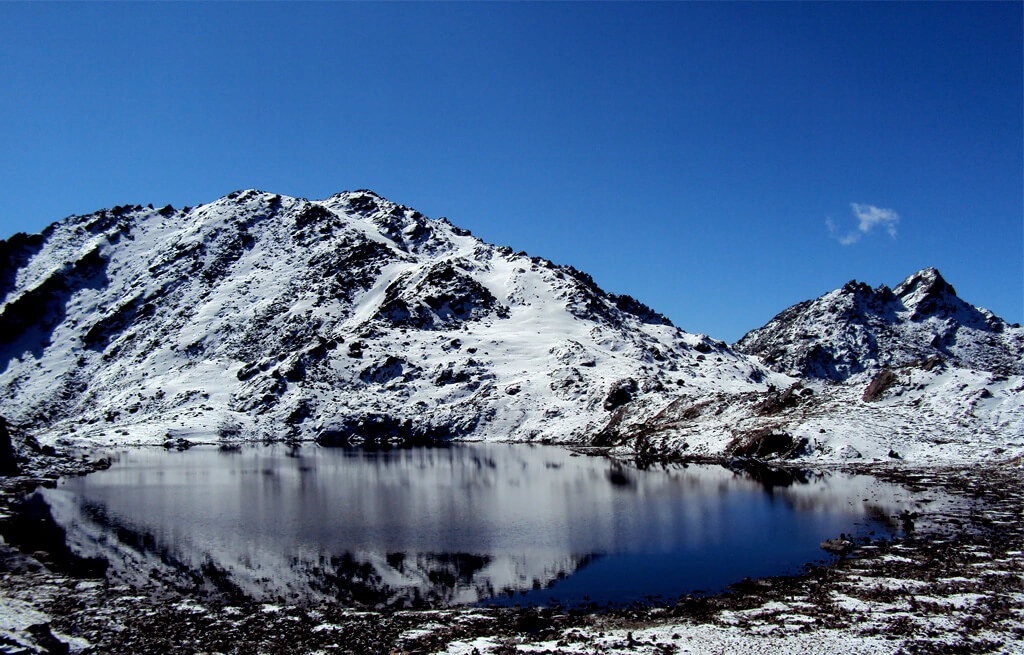
Outline Itinerary of Helambu Trek
Day 1: Drive to Sundarijal (1,380 m) from Kathmandu (1,400 m) and Trek to Chisapani (2,295 m)
Day 2: Trek from Chisapani (2,295 m) to Kutumsang (2,470 m)
Day 3: Trek from Kutumsang (2,470 m) to Tharepati (3,490 m)
Day 4: Trek from Tharepati (3,490 m) to Tarkeghyang (2,600 m)
Day 5: Trek to Sermathang (2,590 m)
Day 6: Trek from Sermathang (2,590 m) to Melamchi Bazar (870 m) and drive back to Kathmandu
Annapurna Base Camp Trek Short Trek
The short 6 day Annapurna Base Camp Trek is the best choice for those looking for a journey that offers beautiful natural scenery and enriching cultural encounters. This trek offers an engaging experience, taking you through the dense forests and several traditional villages. You will cross suspension bridges and trek through scenic villages before reaching the ABC.
The trek begins from the picturesque Samrang. You can witness the charm of the villages like Sinuwa, Himalaya, and Deurali during the trek. Trekking through these mountain villages provides you with an opportunity to connect with local communities. You can get to know their culture and observe their daily lives. The incredible hospitality makes the journey even more fascinating.
You will get a chance to explore Machhapuchhre Base Camp along the route. Upon reaching ABC, you will be rewarded with stunning scenery of Annapurna, Hiunchuli, Gangapurna, Machhapuchhre, and many others.
You will visit Jhinu Danda during the trek, where you can unwind with a warm bath in the natural hot spring. This short Annapurna base camp trek is among the best one week treks in Nepal and rewards you with a pleasant journey in the Annapurna Region, leaving you with memories that you will cherish for a long time.
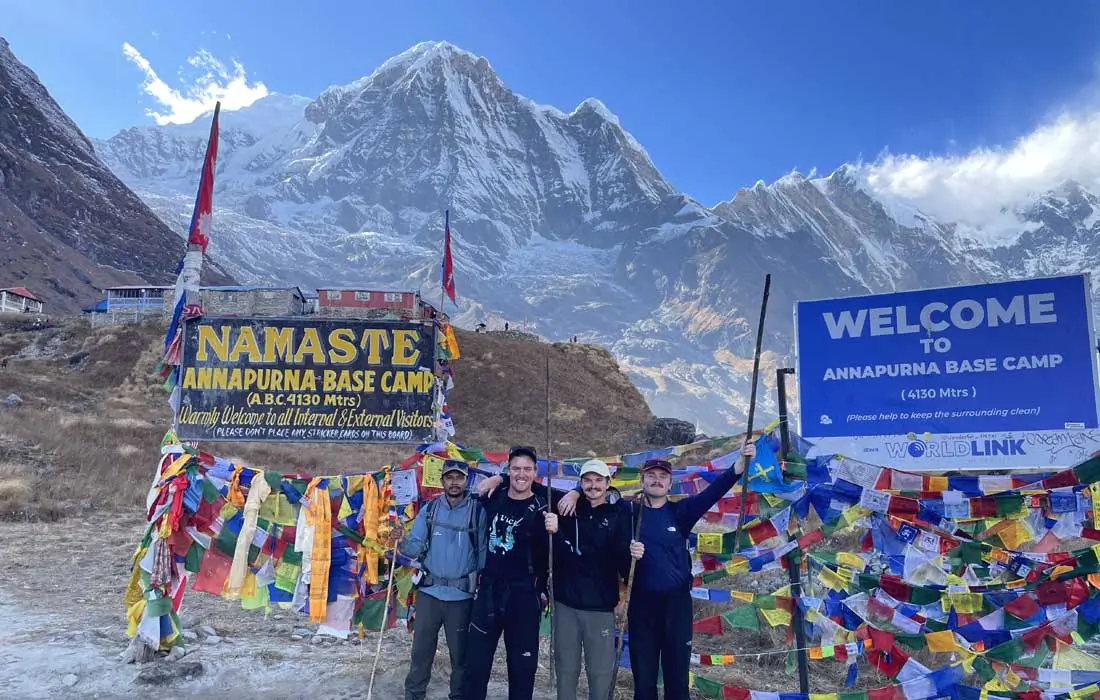
Short Annapurna Base Camp Trek Outline Itinerary
Day 1: Drive from Kathmandu (1,400 m) to Pokhara (822 m)
Day 2: Drive to Samrang (1,790m ) and trek to Sinuwa (2340 m)
Day 3: Trek from Sinuwa (2340 m) to Himalaya (2,920 m) or Deurali (3,230 m)
Day 4: Trek from the Himalaya (2,920 m) to Annapurna Base Camp (4130 m)
Day 5: Trek back to Bamboo (2,310 m) from Annapurna Base Camp
Day 6: Trek to Jhinu Danda (1,780 m) and drive back to Pokhara
Best Time For a One Week Trek in Nepal
Most Recommended Times (Autumn and Spring)
When you are planning for a week-long trek in Nepal, it is essential to choose the most suitable time of the year to trek when the weather is favorable and trail conditions are excellent.
The best time for a week's trek in Nepal is spring (March to May) and autumn (September to November).
These months offer mild temperatures, clear skies, and the best visibility. If you choose to trek during these months, then you can enjoy excellent views of the Himalayas. The trekking trails during these high seasons are filled with other trekkers, and tea houses are in full operation. So, you can have an interactive journey during these seasons
During spring, rhododendrons bloom on the hillsides and forests, making the trekking trails lively and colorful. The weather is moderate with crisp and fresh air. So, it is the ideal time for trekking. In autumn, you can see the striking views of the snow-clad peaks even from a distance. The views of the mountains are most clear this season. The monsoon showers wash the dust and haze off, so you can gaze upon the sharp mountain vistas in autumn.
The weather in these months is stable with very few possibilities of heavy downpour, cloud cover and snow showers, and provides the best trekking conditions. Both seasons offer distinct trekking experiences. The choice between autumn and spring is one of preference and priority.
Spring presents the lively and colorful beauty of nature, and autumn offers blue skies and stunning mountain vistas. Regardless of which season you choose, a week's trek in Nepal is certain to be an unforgettable experience in the mighty Himalayas.
Trekking in Nepal in Summer/ Monsoon (June to August)
Summer/ Monsoon trekking in Nepal offers a serene experience and less crowded trails, as at this time there are fewer tourists on the trail. The landscape is lush during these months and you can see beautiful views of green hills and valleys.
The weather is generally warm during the day, and cools down after a rainfall. However, the higher altitude areas are usually chilly, so layering is important for this season as it is for the others. The fewer crowds and lush scenery reward you with a unique trekking experience.
However, this season also brings heavy rain. The trekking trails of different regions in Nepal become muddy and slippery, which can be relatively difficult to navigate. The weather is unpredictable at this time with frequent downpours, which can also increase the likelihood of landslides.
The leeches in the forests can also add to the difficulty of the trek. The flight cancellations are more usual due to unstable weather. Likewise, the cloud-covered skies can obstruct the mountain views by reducing the visual reward of the hike. Great care and special attention are needed to hike safely during this period.
Trekking in the Winter Season (December to February)
Trekking in Nepal in winter rewards you with stunning views of snow covered mountains. At this time the air is crisp and dry, the skies are clear which offers exceptional views. The trekking trails are generally less crowded. So, you can have a serene journey in the Himalayas. The quiet atmosphere and beautiful mountain views.
While there are immense rewards, there are also some downsides to trekking in this period. Winter presents cold, harsh conditions, especially at high altitudes. The temperatures drop very low in higher areas.
The heavy snowfall can block the routes and may make them impassable. In addition, the extreme cold at high altitudes requires a good level of endurance for cold. If you are planning a one week trek in Nepal, then you will require proper winter trekking gear and careful planning to ensure comfort and safety in adverse conditions. If you plan properly and check the weather forecasts regularly before heading out for a trek, then you will have an amazing experience trekking at this time.
Packing For One Week Trek in Nepal
Clothing:
- Lightweight trekking pants
- Trekking shorts
- Warm Thermal base layers
- Quick-drying Trekking t-shirts
- Fleece jackets
- Down Jackets
- Waterproof jacket and pants
- Sun hats
- Warm hat or beanie
- Lightweight gloves
- Buff
- Bandana
- Moisture-wicking Undergarments
- Gaiters
- Rain Gears
- Windproof Jackets
- Caps
- Gloves
Footwear:
- Waterproof, Trekking boots with ankle support
- Lightweight trekking shoes
- Trekking Sandals
- Gaiters
- Socks (4 to 5 pairs, moisture-wicking
Trekking Gear
- Daypack
- Duffel Bag
- Headlamps
- Water bottle
- Flashlights
- Small Bag locks
- Trekking Route Map
- Trekking poles
Health and Personal Hygiene Items
- Toothpaste
- Toothbrush
- Wet wipes
- Towel
- Tissues
- First Aid Kit (band-aids, paracetamol, and any personal meds)
- Hand sanitizer
- Oximeter
Other Essentials
- Sunglasses (UV protection)
- Headlamp (with extra batteries)
- Camera
- Snacks like energy bars or nuts
- Portable charger
- Mobile Phone
Documents
- Passport and other identification documents
- Travel insurance (including coverage for trekking)
- Trekking permits
- Cash
Tips for a Successful One-Week Trek in Nepal
Train Before You Trek
Trekking in Nepal is immensely rewarding, but the one-week trek in Nepal involves significant altitude gain, rocky trails, and long walking days. So, to enjoy the experience fully, you need to prepare for the trek in advance. Endurance is required while trekking. So, you can build it with cardio exercises like stair climbing, jogging, hiking, cycling, etc. In addition, strength exercises can also help build strength and stamina.
Likewise, you can also hike with a backpack. Hiking in the nearby hills can help to simulate trek conditions. The training before the trek helps you to be fit. You will have more energy to navigate the varied trails and complete the trek smoothly while enjoying every moment.
Pack Wisely
While trekking in the Himalayas, you will need several essentials. However, carrying the extra load can be draining. Generally, if you book the trek package, then the porter will accompany you and support you by carrying the main baggage. So, make sure to take only what you require.
The high-altitude area of the Himalayas is generally on the colder side. So, it is essential to carry base layers, mid layers and outer layers with the required essentials. Packing light helps you have a hassle-free and smooth journey.
Trek with a Guide and a Porter from a Reputed Trekking Agency
Trekking with a guide and porter makes your journey easy and more secure. The Himalayan paths can be challenging, and navigating certain sections can be difficult for those who are not used to walking in such terrains. The guides know about the region and help you in crossing the challenging sections.
In addition, they will also share stories about the nature and culture of the region. They will manage your trekking pace and take care of all the little details to make your journey more enjoyable. With their support, you can stay on track and complete the trek, enjoying every moment.
Likewise, the support of the porter also makes the journey more enjoyable. A week-long trek can be easier when you have a porter by your side who will make your trek easier. Carrying luggage and trekking can make you get exhausted. However, when porters accompany you, you can focus on enjoying the journey while they will transport your luggage safely to the next destination.
Make sure to book your trekking adventure with a reputable trekking agency. The cost of hiring the guides and porter is included in the trek package and you will have a smooth trekking experience.
Stay Hydrated
Maintaining proper hydration is necessary to maintain proper energy levels and ensure overall good health while trekking. When you are not hydrated properly, you may get a headache, feel dizzy, or get muscle cramps, which may affect your trekking performance. Thus, it is essential to be well-hydrated and have little sips frequently. Carry a reusable water bottle in your backpack and make sure you drink it frequently to stay active and healthy throughout the trek.
Choose the Right Trek and Season
All the treks in Nepal offer beautiful scenery. However, it is crucial to select the trek based on your fitness level and your interests. You can research the best one week trek in Nepal. Then, you may choose the one that matches your interests and the kind of scenery you want to see.
In addition, timing is very important. Spring (March–May) and autumn (September–November) are the best trekking periods. These peak seasons are blessed with clear weather, pleasant temperatures, dry trails and stunning views. When you pick the right trek, you will be rewarded with the enchanting mountain vistas and have a generally smooth and delightful trekking experience.
Learn about Altitude Sickness and the Acclimatization Process
Altitude sickness can be one of the concerning aspects while trekking at high altitudes, especially above 2,500 m. The one-week trek in Nepal also takes you to several high-altitude areas. Thus, you must give your body time to adapt to the high altitudes and ensure acclimatization.
Some symptoms of altitude sickness are:
- Headache
- Trouble Sleeping
- Appetite Loss
- Vomiting or Nausea
- Dizziness
You must take preventive measures to lower the likelihood of altitude sickness. Make sure to stay hydrated. In addition, trekking slowly is equally important and helps in proper acclimatization. You must take gradual steps and not overexert yourself. Rushing while climbing the hill exhausts you and increases the probability of altitude sickness.
Listen to your guide's instructions, rest when required, and let your body adjust to the altitude gradually. There are medications available that can reduce the risk. However, it is advisable to take a doctor's advice before taking it.
Respect Local culture and follow the Regulations
While trekking in Nepal, you will pass through the villages and get a chance to visit many monasteries. So, it is important to be respectful of the nature and culture of the region. You need to be considerate of the regulations. You should take off your shoes in homes or temples, seek permission before taking pictures of people or religious structures and make sure not to throw garbage on the trail.
Instead, you can pack out the garbage and throw it in designated bins. In addition, you should only walk through the marked trails. This reduces the chances of getting lost and doesn't harm the ecosystem of the Himalayas. You are contributing to the protection of the natural environment and maintaining a good bond with the local communities by following the local regulations, which enhances your overall experience.

